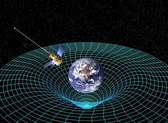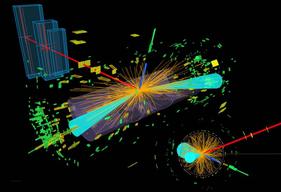


| Quantumology |
|
 Any research into Einstein will unveil a man of many parts. He considered himself a humanist above a scientist, and despaired of the general ignorance prevalent in mankind. He didn't want to know about Relativity, he just did, and That One was the one that spurred the scientific sentience into action. From there came the quantum realms, the places where ‘General' just didn't apply, and in that seething maelstrom of chaos Einstein wasn't comfortable at all. He spent his dying hours attempting to impose an order on it. We could safely guess the answer came to him in the end.  But we're in a different generation now, with a whole new set of parameters. We've got an expanding universe accelerating before our very eyes and we haven't a clue why it's doing that. What does it matter? Does it matter? Well, yes, I guess it matters, especially if it makes a difference to the way we live, and the way we relate to our planet. Einstein saw it coming, the devastation and mass-scale waste, technology overriding humanity, all the stuff of dark matter in the making. He didn't have the technology that the Dark Matter Hunters have, with all the fancy telescopes and bits of computers that generate images from Data.  So relatively speaking, if everyone can agree that we're quantum, and that we do what quantum particles do - possibly, I don't mind a fence being there if you want one - perhaps we can afford to look at the Universe as a source of information in itself, rather than just something to be analysed. And if we can do that, who knows what it could tell us? Did we dream that? "Don't hold your dreams too hard, they're china in your hand.$" T'Pau Pictures have stories to tell too
0 Comments
This Blog is worth sharing, I think, because I've not linked like this before, but now that I've been to Oxford and had a discussion with Pedro, I think maybe it's time a little more linking took us a lot closer to where we need to be.
 Under a full moon, the Large Hadron Collider was unveiled before a public audience at Oxford University tonight. The schematics of its workings were described and photos of its inner parts revealed by Tony Weidberg, then Nazim Hussain went into detail about the particles which it and other experiments were destined to capture. The talks were certainly informative, and pitched for an audience of non-academics which was refreshing, bringing the whole issue of particle physics back to basics and covering some things of acute importance along the way. Leptons, for instance. I'd long puzzled over complex descriptions of leptons I'd come across in my years of trawling through scientific papers. Now to be presented with a simple diagram of the Standard Model I could see a context in their relation to each other, and to the quarks and force-carriers which partner them in the Particle Zoo. This presented a question in my mind, which I dutifully asked from the auditorium. "We're familiar with electrons," I said, "and with electron-neutrinos, but what about the Tau? Where, in the natural everyday world, would you find a Tau?" The answer returned from the podium was a little short, bringing to my personal vault of paranoia a ringing reminder of what happened at the Paris Cosmology Colloquium (covered in Quantumology). Apparently, you don't find Taus in everyday existence because they don't exist for long enough to be part of everyday life. So I went out to the foyer after the lectures, where an array of illustrative objects and experiments had been laid out, and investigated further. If electrons are thought to live as long as the Universe, or thereabouts, how come the Tau, being of the same family, hardly exists for any time at all? What's the connection?  Turns out the only thing they share is a charge and a spin. Electrons, muons and taus are leptons because they have the same charge and the same integer spin, and that, folks, is where the similarity ends. Taus are huge, electrons are tiny, and muons are somewhere in between. So the Goldilocks recipe for leptons is clearly defined. We have to contend with a universe stuffed with electrons because they live forever, being so small. Size, it seems, far from being everything, is a bit of a handicap in the Particle Zoo. Their leptonic partners the Neutrinos follow the same pattern of mass, and the discovery of their mass came about because they oscillate (thanks to luminescent physics student Kathryn Boast for that gem of information). To oscillate, you have to have mass. We are, therefore we oscillate, in other words. Neutrinos oscillate from one form to another without suffering any apparent after-effects such as death. But the other leptons, electrons excepted, are too heavy to withstand the pressure of living in this Universe without collapsing under their own weight, and decaying (the scientific term for falling to bits) into other particles. This from Wikipedia (laugh if you want, but send a complaint only if it's wrong): "The tau is the only lepton that can decay into hadrons – the other leptons do not have the necessary mass. Like the other decay modes of the tau, the hadronic decay is through the weak interaction. The branching ratio of the dominant hadronic tau decays are: 25.52% for decay into a charged pion, a neutral pion, and a tau neutrino; 10.83% for decay into a charged pion and a tau neutrino; 9.30% for decay into a charged pion, two neutral pions, and a tau neutrino; 8.99% for decay into three charged pions (of which two have the same electrical charge) and a tau neutrino; 2.70% for decay into three charged pions (of which two have the same electrical charge), a neutral pion, and a tau neutrino; 1.05% for decay into three neutral pions, a charged pion, and a tau neutrino. In total, the tau lepton will decay hadronically approximately 64.79% of the time. Since the tauonic lepton number is conserved in weak decays, a tau neutrino is created when a tau decays to a muon or an electron." Which is just a list of the discovered bits a tau will turn into when it's fallen apart. This, again from Wikipedia, explains what a Pion is: "In particle physics, a pion (short for pi meson, denoted with p) is any of three subatomic particles: p0, p+, and p-. Each pion consists of a quark and an antiquark and is therefore a meson. Pions are the lightest mesons and they play an important role in explaining the low-energy properties of the strong nuclear force. Pions are unstable, with the charged pions p+ and p- decaying with a mean life time of 26 nanoseconds and the neutral pion p0 decaying with an even shorter lifetime. Charged pions tend to decay into muons and muon neutrinos, and neutral pions into gamma rays." You can see from this, that pions, made of quarks, themselves fall to bits very quickly (26 nanoseconds is less than a standard blink, by a long shot) and they turn into muons, muon neutrinos and gamma rays. So in all this lurks another quandary. Where does all this falling-to-bits actually end? Is it a case of ‘out of sight, out of mind'? We know about gamma rays, but is there a further outer-space to the electromagnetic spectrum we don't yet know about? Just because something is on the edge of our line of sight doesn't mean there isn't more over our shoulder. There was another thing to come out of this evening's lectures which I found rather palatable. The LHC has an experiment running called the ‘LHCb' - and the ‘b' stands for ‘beauty'. As in ‘beauty', partner of ‘truth', those perspicacious quark names which were dropped in deference to ‘bottom' and ‘top'. Regular readers will know that I found the whole business of quark anti-christening very distasteful indeed, so I was thrilled when Nazim mentioned the LHC Beauty experiment in his talk. He said at the time he'd come back to it later, so I waited breath bated, but he didn't, so when the lecture closed I asked, "As Bottom used to be Beauty, and you've mentioned the LHC Beauty experiment, is there any connection here with the Beauty quark?" And yes, there certainly was, because the Beauty quark apparently has some strange quirks of symmetry to it which the particle physicists are keen to unravel. For sure I'll be doing some unravelling of my own, then, and finding out more about this quarkish adventure. Watch this space. I'll come back to it later. |
AuthorKathy Ratcliffe has studied quantum mechanics since 1997 in a life surrounded by birds and animals, She's a metaphysicist, if such a thing exists, looking as we all are for the inevitable bridge between humanity and particle physics. Archives
April 2023
Categories |